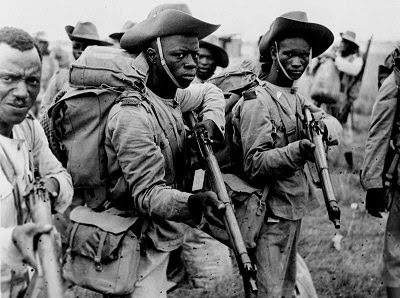Commonwealth African soldiers in World War II
During the war, the demand for manpower increased significantly. The healthiest part of the African population was taken into the army. Tanganyika alone gave the army 86,740 people. To provide labor for industrial enterprises and plantations, the colonial authorities took the path of widespread use of forced labor.
The use of forced labor in Tanganyika was based on the Forced Labor Act of 1940, and in Kenya on the basis of the so-called Defensive Order of 1942. In Uganda, no new forced labor legislation was enacted during the war, as the forced labor system existed there before the war.
In Buganda, Uganda province, every adult male was required to work in public works without any pay for 30 days a year. Forced labor could be replaced by a monetary contribution of 10 to .14 shillings known as Tuvalu.
Many Africans were mobilized for forced labor in East Africa during the war years. In the study already cited by us on the economic resources of Tanganyika, the number of those mobilized for labor work in Tanganyika in 1940-1945. is determined at 22 - 23 thousand people per year. According to another researcher, O. Brown, the number of people mobilized for labor work in Kenya ranges from 10 to 22 thousand per year.
By the end of the war, roughly 10% of all working Africans were in forced labor. The mobilization of Africans for forced labor had a very hard impact on the state of agriculture. Quite often African families could not cultivate their piece of land due to the lack of able-bodied men.
Unbearable housing conditions, combined with a hungry existence, led to a high mortality rate among workers mobilized for forced labor. It is no coincidence, therefore, that Africans fled from work at the first opportunity.
As Macmillan told MPs in November 1942, there were 545 judicial desertions in Kenya. On the rubber plantations of Tanganyika, 468 people deserted in 15 months (from October 1942 to December 31, 1943).
By maximizing the production of branches of agriculture important for the needs of wartime, the colonial authorities completely ignored the interests of the African population. The mobilization of the able-bodied part of the male population into the army and for labor work had a heavy impact on the situation of African agriculture.
Low yields led to constant malnutrition and hunger. One of the staple foods for Africans is corn. Corn was grown in all provinces of Kenya, Uganda and Tanganyika. A significant amount of it was produced on European plantations in Kenya.
Almost all of the corn crop was consumed locally. There are no exact statistics on corn production in East Africa before and during World War II. Nevertheless, it is known that the sowing of corn during the war years was significantly reduced.
The standard of living of the African population of British East Africa, which was always extremely low, reached the level of a hungry existence during the war years. In 1942 - 1943. famine raged in East Africa, killing thousands.
The British colonial authorities spread the version that the famine in East Africa was caused by the lack of rain and a plague of locusts. The governor of Kenya and the British Colonial Minister Stanley spoke about this.
This version was refuted by a commission set up to investigate the causes of food difficulties in Kenya. In her report, she acknowledged that the food difficulties were caused by the reduction in maize crops. But the commission also did not reveal the main reason for the famine, which was that the colonial authorities did not want to take into account the vital needs of the indigenous population.
As noted above, a large variety of products were exported from East Africa for the needs of the British army. This could not but cause an acute shortage of food, because before the war, a significant amount of food, on the contrary, was imported into East Africa from other countries.
Even more important was the fact that the African village lost its able-bodied male population during the war years. In Kenya, for example, in 1943, out of 642 thousand able-bodied Africans, 370 thousand, or 57%, were either mobilized into the army and for labor work or worked for hire outside the reserves.
In addition, European farms in Kenya, which had grown a significant amount of corn before the war, during the war significantly reduced the crops of this crop, since it was more profitable for them to grow sisal, pyrethrum, wheat, flax. Naturally, for these reasons, food production in the African countryside has dropped sharply.


No comments:
Post a Comment